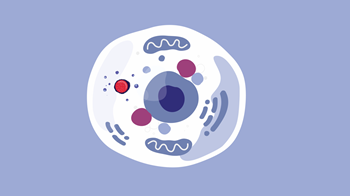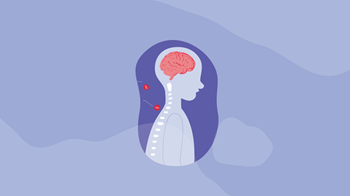Tay-Sachs disease and Sandhoff disease are the two most common types of GM2 gangliosidosis (GM2), a group of rare fatal genetic disorders that progressively damage nerve cells primarily in the brain and spinal cord. Learn how gene therapy is being researched as a potential one-time treatment that could slow or stop disease progression for both diseases.
About GM2

Lysosome working to breakdown HexA enzymes
Cause of disease –Tay-Sachs disease is caused by a mutation (e.g. variant or change) to the HEXA gene and Sandhoff disease is caused by a mutation to the HEXB gene. Although they are caused by different genes, they both instruct the cells to produce parts of an important enzyme called beta-hexosaminidase A (HexA enzyme). This enzyme helps break down molecules called GM2 gangliosides in the lysosomes within cells. Often referred to as the “recycling center” of cells, lysosomes break down and remove waste to allow cells to function properly. As a result of the faulty genes, there is not enough of the HexA enzyme, leading to a harmful build up of GM2 ganglioside, which is toxic to cells.
Symptoms – GM2 typically appears during infancy, but can also occur in early childhood, adolescence or even adulthood. In younger children, these symptoms progress quickly and can include a loss of developmental skills, impaired brain function, seizures, difficulty breathing or swallowing, and lead to severe disability and shorter life expectancy. In older children (juvenile onset) and adults (late onset) symptoms may include weakness, unsteadiness, and speech difficulties.
Gene Therapy Approach
.aspx?width=350&height=350) Gene therapy is being researched to potentially treat both Tay-Sachs and Sandhoff disease. Gene therapy aims to be a one-time treatment that could slow or stop disease progression by delivering working HEXA and HEXB genes into the cells using a viral vector. Scientists know that viruses are good at getting into cells, so they have learned how to safely use this ability as a carrier to deliver working genes. But don’t worry, the viral genes are removed, so only therapeutic (intended) genes are delivered. The viral vectors carrying the working HEXA and HEXB genes are delivered at the same time through a single injection. This injection could be intra-cisterna magna, meaning it is given at the base of the skull into the space containing fluid that surrounds the brain and spinal cord. Similarly, an intrathecal injection could be given as a lumbar puncture in the lower back. Since the treatment is delivered directly into the body, this is called an in vivo gene therapy approach. Once delivered, the working genes instruct cells to make the lacking HexA enzyme. The goal is to restore how lysosomes function, which is to remove and prevent the build up of toxic gangliosides.
Gene therapy is being researched to potentially treat both Tay-Sachs and Sandhoff disease. Gene therapy aims to be a one-time treatment that could slow or stop disease progression by delivering working HEXA and HEXB genes into the cells using a viral vector. Scientists know that viruses are good at getting into cells, so they have learned how to safely use this ability as a carrier to deliver working genes. But don’t worry, the viral genes are removed, so only therapeutic (intended) genes are delivered. The viral vectors carrying the working HEXA and HEXB genes are delivered at the same time through a single injection. This injection could be intra-cisterna magna, meaning it is given at the base of the skull into the space containing fluid that surrounds the brain and spinal cord. Similarly, an intrathecal injection could be given as a lumbar puncture in the lower back. Since the treatment is delivered directly into the body, this is called an in vivo gene therapy approach. Once delivered, the working genes instruct cells to make the lacking HexA enzyme. The goal is to restore how lysosomes function, which is to remove and prevent the build up of toxic gangliosides.
Treatment Pipeline
 The current standard of care for Tay-Sachs and Sandhoff disease aims to relieve symptoms, but do not alter or stop how the disease may progress. Better treatment options for people living with these diseases, such as gene therapy, are currently being investigated in clinic trials and preclinical studies. Clinical trials are a required part of the research process that aims to understand the way a drug or treatment will interact with the human body and whether it is safe and effective. Preclinical studies are an even earlier stage of research that test the safety and effectiveness of a treatment in animal or cell-based models before proceeding with a human clinical trial. Clinical trials may differ on various aspects of their design. If you are considering an investigational gene therapy through a clinical trial, it would be best to discuss your options with a healthcare provider or a member of the clinical trial research team.
The current standard of care for Tay-Sachs and Sandhoff disease aims to relieve symptoms, but do not alter or stop how the disease may progress. Better treatment options for people living with these diseases, such as gene therapy, are currently being investigated in clinic trials and preclinical studies. Clinical trials are a required part of the research process that aims to understand the way a drug or treatment will interact with the human body and whether it is safe and effective. Preclinical studies are an even earlier stage of research that test the safety and effectiveness of a treatment in animal or cell-based models before proceeding with a human clinical trial. Clinical trials may differ on various aspects of their design. If you are considering an investigational gene therapy through a clinical trial, it would be best to discuss your options with a healthcare provider or a member of the clinical trial research team.
To stay up to date on active and recruiting clinical trials that may become available in the U.S. or globally, visit ClinicalTrials.gov or the Gene Therapy Trial Browser.
Participating in a Clinical Trial
It is important to be well informed when deciding to participate in a clinical trial. Below are some key points to consider. Go to the considering a clinical trial page for more information and resources to help guide you.
-
Eligibility - Eligibility for a trial is based on strict inclusion and exclusion criteria. These are specific factors that determine whether a person can or cannot enroll in a clinical trial. This is an important way for researchers to understand if the gene therapy is working properly and to ensure participant safety. These criteria may include factors such as age, how advance the disease is, medical history, or previous use of investigational treatments. Speak with a healthcare provider or a member of the clinical trial research team to help determine if you or your child may be eligible for a clinical trial.
-
 Risks – As with any medical intervention, there are risks that need to be carefully considered. Before participating in a clinical trial, a member of the research team should review any potential risks and benefits with the patient or caregiver. Therapies being studied in clinical trials are not a guaranteed cure and cannot guarantee beneficial results. There is always a chance that the investigational treatment may not work. In the event a person is not satisfied with the outcome, the person may not receive another dose of the gene therapy. In addition, participating in a clinical trial may prevent future participation in other trials or from receiving other types of treatments. Gene therapy can be an alteration for the lifetime, so people should be aware that there could be long term effects (both good or bad) that are not known at this time.
Risks – As with any medical intervention, there are risks that need to be carefully considered. Before participating in a clinical trial, a member of the research team should review any potential risks and benefits with the patient or caregiver. Therapies being studied in clinical trials are not a guaranteed cure and cannot guarantee beneficial results. There is always a chance that the investigational treatment may not work. In the event a person is not satisfied with the outcome, the person may not receive another dose of the gene therapy. In addition, participating in a clinical trial may prevent future participation in other trials or from receiving other types of treatments. Gene therapy can be an alteration for the lifetime, so people should be aware that there could be long term effects (both good or bad) that are not known at this time.
-
Benefits – Participating in a trial may offer many potential benefits compared to not receiving any form of intervention for a fatal disease. Gene therapy aims to be a one-time treatment with lasting positive effects that slow or stop disease progression for a lifetime. However, there is no guarantee. If gene therapy is received earlier in the course of disease, it has the potential to stop damage before it occurs.
-
Long-term follow up – It is the patient’s responsibility to comply with the long-term follow-up of a trial. The Food and Drug Administration (FDA) guidelines require the clinical trial research team to monitor safety and potential long-term effects of a gene therapy. Follow-up may require in-person appointments that vary in frequency and location, or completion of mailed packets with response forms. The need for long-term data collection for a gene therapy trial can last up to 15 years—another reason to consider all outcomes and responsibilities that come with committing to a clinical trial. There are a limited number of participants in trials so a lack of attendance at follow-up appointments leads to not enough study data. This could negatively affect FDA approval of a new therapy and thereby limit access to the therapy by patients who did not participate in the clinical trial.
Access
At this time, we do not know if or when gene therapies will be approved by the U.S. Food and Drug Administration (FDA) and commercially available for people living with different types of GM2. The overall process may take several more years, until it is deemed safe and effective by the FDA or the regulatory agency in other countries.
Stay Informed
 There are many patient advocacy organizations to follow or get involved with. They work hard to fund research and advocate for patient and family needs. They are also a great way to connect with others affected by the disease if you are looking for support and advice.
There are many patient advocacy organizations to follow or get involved with. They work hard to fund research and advocate for patient and family needs. They are also a great way to connect with others affected by the disease if you are looking for support and advice.
National Tay-Sachs and Allied Diseases Association
Cure Tay-Sachs Foundation
Cure & Action for Tay-Sachs Foundation
Was this information helpful? If so, please feel free to share these resources by referencing the GM2 media kit!